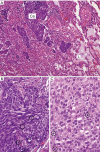Case presentations and recommendations from the 2018 ITMIG Annual Meeting
- PMID: 35118275
- PMCID: PMC8794334
- DOI: 10.21037/med.2020.01.01
Case presentations and recommendations from the 2018 ITMIG Annual Meeting
Abstract
The 9th International Thymic Malignancy Interest Group's (ITMIG) Annual Meeting was held in Seoul, South Korea in October 2018, and in this article, we discuss three of the cases presented and review the radiology imaging and pathology slides. The first two cases involve thymic carcinoma: the first reviews systemic therapy recommendations for non-resectable recurrence and the second case the optimal treatment recommendations after incomplete resection. The third case discusses treatment recommendations for recurrent thymoma after complete resection.
Keywords: Thymoma; case presentation; thymic carcinoma; tumor board.
2020 Mediastinum. All rights reserved.
Conflict of interest statement
Conflicts of Interest: All authors have completed the ICMJE uniform disclosure form (available at http://dx.doi.org/10.21037/med.2020.01.01). ACR serves as an unpaid Associate Editor of Mediastinum from May 2017 to Apr 2019 and from Jul 2019 to Jun 2021. MM and CBF serves as an unpaid editorial board member of Mediastinum from May 2017 to Apr 2019 and Jul 2019 - Jun 2021. EMM reports honorarium for lecture from Bristoll-Meyers Squibb, Boehringer Ingelheim, and Merck Sharp and Dohme, outside the submitted work. The other authors have no conflicts of interest to declare.
Figures








References
-
- Ettinger DS, Wood DE, Aisner DL, et al. Thymomas and thymic carcinomas [v2.2019]. In: National Comprehensive Cancer Network. 2019. Available online: https://www.nccn.org/professionals/physician_gls/pdf/thymic.pdf. Accessed May 2019.
-
- Detterbeck FC, Stratton K, Giroux D, et al. The IASLC/ITMIG thymic epithelial tumors staging project: Proposal for an evidence-based stage classification system for the forthcoming (8th) edition of the TNM classification of malignant tumors. J Thorac Oncol 2014;9:S65-72. 10.1097/JTO.0000000000000290 - DOI - PubMed
Publication types
LinkOut - more resources
Full Text Sources
